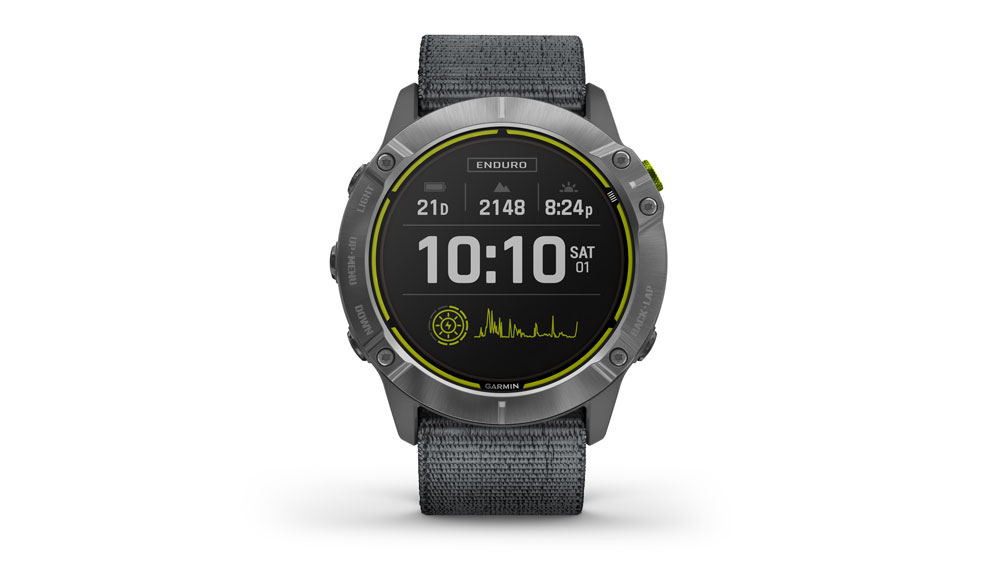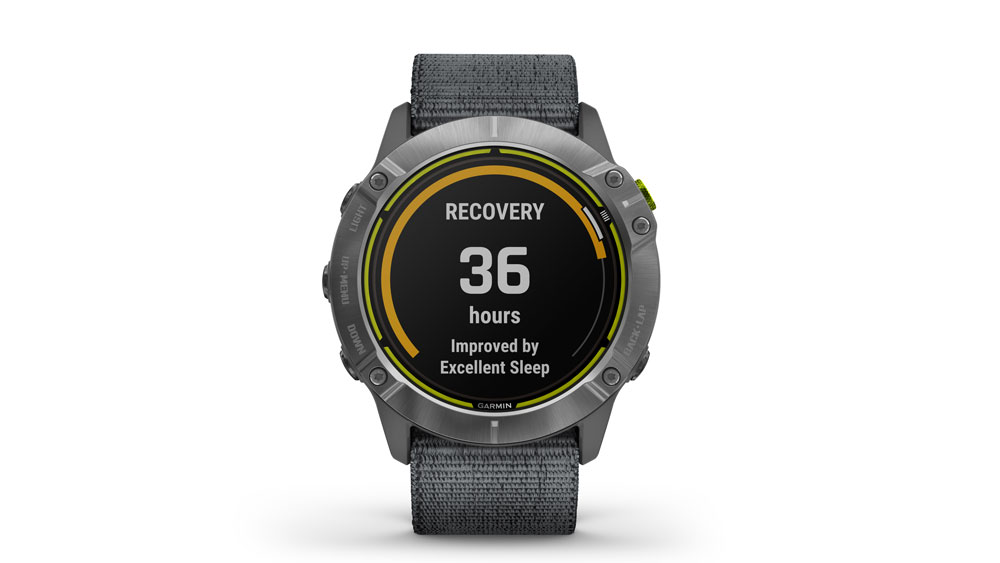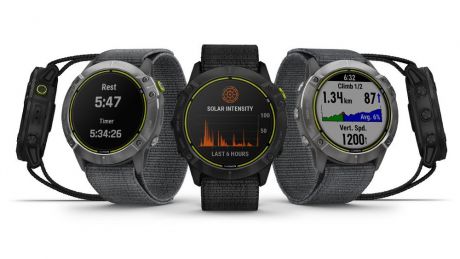Our Verdict
The Enduro lives up to its name by offering superlative battery life, but the trade-off is losing colour maps and music storage, which is a tough pill to swallow at this price.
For
- Amazing battery life
- Brilliant sports tracking and training analysis
- Breadcrumb navigation
Against
- No music or maps
- Very expensive
You can trust Coach
It’s not hard to see what the main selling point of the Garmin Enduro is – it’s right there in the name. This is a watch built to last, which is clear from both its rugged design and its long battery life. Garmin claims the watch offers 70 hours of GPS, which rises to 80 when the solar panels on the watch face can make use of sunny conditions, and it can last up to 65 days with general use.
So how well does the battery perform in the real world? Extremely well indeed. The Enduro lasted me 23 days in total, and in that time I logged over 305km of outdoor running using the GPS for more than 21 hours, as well as another 10 hours or so of indoor workouts.
No other watch has lasted me as long. The Coros Vertix comes closest by sometimes reaching three weeks of use, but that’s more like the minimum I’d get from the Enduro. It’s also the only watch I was happy to use for a 25km run when I had less than 5% battery. You don’t even get a low battery alert until it hits 2%. You can also use low power modes to extend the Enduro’s tracking to 300 hours, which is again exceptional.

So it’s a big tick in the battery life box – which should have the people at Garmin breathing a huge sigh of relief, because it’s pretty important if you’re shelling out for the Enduro. It costs £699.99 for the steel model or £799.99 for the lighter titanium version – that’s more expensive than Garmin’s flagship Fenix 6 Pro and Forerunner 945 devices, which offer more features but not such stellar battery performance. There are colour maps on the 6 Pro and 945, as well as music storage and the ability to sync to premium streaming services like Spotify to listen to playlists offline. I’ve long wanted a stripped-back version of the Fenix that maxed out battery life in exchange for losing features like these, but I did expect it to be cheaper than the Fenix.
The Enduro does bring to the table some new ultramarathon-focused features, such as a dedicated ultrarunning mode where you can log your rest breaks at aid stations, plus a trail run VO2 max estimate, which takes into account the terrain you’re running on to provide more accurate results. However, these features are now on the Fenix as well and they all are set to come to the 945 too (some already have), so the difference really comes down to battery life and design.
On the design front the titanium Enduro scores well. It’s surprisingly lightweight given that it’s a bigger watch, in line with the size of the Fenix 6X Pro. The case measures 51 x 51 x 14.9mm, but the titanium watch weighs just 58g. Even the cheaper steel Enduro is 72g, whereas the Fenix 6 Pro is 83g in steel and the 6X Pro is 93g.
Part of that difference comes down to the Enduro’s nylon strap, which is comfortable and lighter than the standard silicone options Garmin uses. It dries impressively quickly, too. I never felt that it was slimy and wet on my wrist after a shower. Hopefully this style of band is something Garmin will make available for all of its devices.
While it does lack music and maps, the Enduro does get most of the key features on Garmin’s other high-end watches. In terms of routing there is breadcrumb navigation and a back to start pointer, and the routes you load on to the watch also use Garmin’s ClimbPro feature. This picks out all the climbs and descents on your route, so you can see how much uphill work you have to do and pace yourself accordingly. Given the watch is likely to appeal to long-distance trail runners, this is a welcome feature.
There is also in-depth training analysis, including details on how you’re acclimatising to altitude and heat, plus a breakdown of your workouts into three sections: low aerobic (easy runs), high aerobic (tempo or threshold efforts) and anaerobic (sprint interval sessions). You’ll get workout suggestions based on how the Enduro rates the balance of your training across those three categories, and it will also advise on recovery time, even shortening what it suggests if you have an especially restful day after a workout. This is all par for the course for Garmin devices from the Forerunner 745 up, but it remains an impressive level of detail and support for your training.

To take advantage of this analysis you are going to want an external heart rate monitor such as a chest strap, because although the Enduro is no less accurate than other watches, it still misread my pulse regularly on the run and during other activities. This skews the training effect of your sessions and your overall training load advice, so pairing it with a chest strap is essential. You can do this via both ANT+ and Bluetooth so you can be confident the Enduro will work with a strap you already own.
For GPS accuracy the results were better. The Enduro was generally accurate for me, and on a local 2.475km wheel-measured loop (I measured it because I’m obsessive and needed an accurate loop for training during lockdown) it consistently logged around 2.51km.
It was a little generous on distance tracked, especially on looped courses. On a shorter 850m loop (roughly – no wheel used here) I run regularly for “track” workouts, it would always overestimate and so give me more credit in terms of my pace. However, overall the watch’s readings were almost always within a fair margin of error, and it has Garmin’s Track Run mode for extra accuracy once running tracks reopen.
See related
- The Best Running Watches Of 2021
- How To Buy The Best Garmin Fitness Tracker For You
- The Best Trail Running Shoes For 2021
The Enduro also offers daily activity and sleep tracking. On the first front it is pretty impressive, logging all the standard stats like steps and calories, and the 24/7 heart rate tracking is accurate. You also get Garmin’s Body Battery feature, which provides a snapshot of your energy levels rated out of 100, taking into account your recovery and workouts.
However, sleep tracking is less impressive. Garmin watches tend to inflate sleep duration and this proved no exception, adding time on at the start of the night if I was fairly still while reading or watching TV. More importantly I struggled to wear the Enduro every night because it is a big watch. I’m a little fussy on this kind of thing, so it might not be a problem for you, but eventually I started taking it off at night after a couple of times when I woke up and it was annoying me.
Whether you should buy the Enduro is a pretty easy question to answer. It performs well on all the usual Garmin fronts, offering great sports tracking and training analysis, and solid navigation with breadcrumb trails enhanced by ClimbPro. The key feature, though, is undoubtedly the battery life, and if you’re not all that bothered about it, the Fenix 6 Pro or Forerunner 945 are better options within Garmin’s range.
Outside of Garmin you get a pretty amazing battery life on the Coros Vertix, which costs £600, though it lacks the level of training insight you get from the Enduro. If the longevity of every other multisport watch isn’t enough, the Enduro is the watch for you, but if you’re happy to trade a little juice for extra features and a lower price there are better options.
Buy from Garmin | £699.99-£799.99

Nick Harris-Fry is a journalist who has been covering health and fitness since 2015. Nick is an avid runner, covering 70-110km a week, which gives him ample opportunity to test a wide range of running shoes and running gear. He is also the chief tester for fitness trackers and running watches, treadmills and exercise bikes, and workout headphones.

